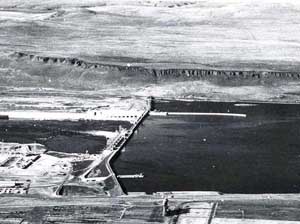On September 23, 1954, President Dwight D. Eisenhower dedicates McNary Dam located on the Columbia River near Umatilla, Oregon, and Plymouth, Washington, 292 miles from the mouth of the river. The dam is named for Oregon Senator Charles L. McNary (1874-1944), who spearheaded efforts to resolve problems of navigation on the river. The dam is 7,365 feet long and towers 183 feet over the riverbed.
Rapids, Waterfalls, Low Water
As early as 1896 merchants and farmers recognized the need for better navigation on the Columbia River. Rapids and waterfalls required that freight, produce, and passengers be transferred from riverboats to roads and railroads. Seasonal fluctuations in the river's level restricted traffic several months a year.
In 1911, the Open River Navigation Association was the first organization to lobby for a dam near Umatilla Rapids. In 1916, the Umatilla Watershed Association formed and in 1920, the Umatilla Rapids Association organized. These two groups advocated building a dam. During 1923-1924, the U.S. Reclamation Service studied the proposed site to see if a dam was feasible. Congress later ordered a complete study of the Columbia River. This was done by the U.S. Army Corps of Engineers from 1928 to1931. The Corps recommended dams in 10 places on the Columbia and Snake rivers. It looked as if the dam at Umatilla Rapids would finally happen.
Critics in Congress ridiculed the idea of building McNary Dam. They wondered who would use the electricity in such a sparsely populated area. They argued that the dam would stop salmon from getting to their spawning beds and that barge traffic would stop. But the obstacles were eventually overcome and Congress appropriated the necessary funding in 1945. Construction began in May 1947. The reservoir behind McNary Dam began to rise in December 1953 and McNary delivered its first electricity to the Bonneville Power Administration in 1954.
Celebrating the Dam
Approximately 30,000 people crowded the powerhouse to hear the President Eisenhower's dam dedication speech. The Very Reverend Matthew M. Cortty gave the invocation and Secretary of the Army Robert Stevens and Secretary of the Interior Douglas McKay represented the federal government. Washington governor Arthur B. Langlie (1900-1966) and Oregon governor Paul L. Patterson (1900-1956) gave speeches praising the benefits of the dam. J. T. Bettinson, chairman of Benton County Board of Commissioners and J. M. Doyle from Plymouth were also on the dais.
President Eisenhower pressed the button to activate, for the first time, the dam's fifth generator, bringing the dam to a capacity of 350,000 kilowatts. After the ceremony, spectators were treated to a tour of the structure, musical bands and singers, and a water show.
The McNary Lock and Dam includes the dam itself, a 64-mile-long reservoir (Lake Wallula), powerhouse, navigation lock, two fish ladders, 18 miles of levees, pumping plants, and ancillary buildings. The growing cities of Pasco, Kennewick, and Richland use the power generated. The fish ladders allow salmon to swim upstream to their spawning beds. The locks easily move barge and tug traffic up and down the river. The opponents' arguments were put to rest.

